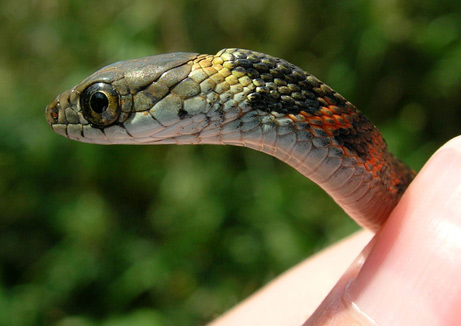tags: Rhabdophis tigrinus, snake, toad, toxins, evolution
The Asian snake, Rhabdophis tigrinus, obtains toxins from toads it eats and uses the potent chemicals as a defense against predators, according to a new study.
The toxin-containing glands are clearly visible on this juvenile snake as a large ridge on the back of the neck. The snake is native to the toad-rich island of Ishima, Japan.
Contrary to popular belief, not all poisonous snakes actually manufacture their poisons. In fact, according to a newly published study, some snakes obtain their poisons from their diet and store them in special glands until they use them in self-defense.
Such is the case with the Asian snake, Rhabdophis tigrinus. This snake has evolved so it can safely consume poisonous toads. These toxic toads make their own poisons, known as bufadienolides, to protect themselves against predators, which learn not to eat the deadly amphibians. But after eating the toads, this snake stores the bufadienolides in glands in its neck, making the snake too poisonous to eat.
"Sequestration of toxins in a specialized [neck gland] structure in a vertebrate is a remarkable finding," said William Zamer, IOS deputy director at NSF. "This finding offers new insights into the complex mechanisms underlying ecological relationships and will lead to important insights about fundamental biological questions."
A large dose of these toxins can stop the heart of a would-be predator, while a lower dose likely would affect the predator's muscles and nerves, slowing it down. The adaptation is obviously a potent survival tool for the snakes: the snakes respond to its predators with stylized movements that take advantage of its stored toxins, teasing its predators into taking a swipe or a bite
"The snakes bend their head over and expose the glands on the back of their neck," said Deborah Hutchinson of Old Dominion University in Norfolk, Virginia, a co-author on the study with colleagues in the U.S. and Japan. "They also ... do neck-butting, where they actually move the neck toward the attacker."
These toxins have also affected the snakes' behavior. A different population of the same species of snake also lives on toad-free islands, which were separated from the toad-filled islands more than 10,000 years ago when sea levels rose at the end of the last Ice Age. But these toxin-free cousins evolved into scaredy cats who do not respond aggressively to predators.
There are many frogs and even a few bird species are known to obtain toxins from their diet, but their source is usually invertebrates such as insects. This is the first example of a vertebrate known to get its supply of poisons from another vertebrate.
Interestingly, female snakes pass the toad toxins on to their offspring to protect them while they are too young to eat the toads themselves. This transfer occurs while a mother snake is still carrying eggs in her body.
"That's the coolest part of the study," said Edmund Brodie III, an evolutionary biologist at the University of Virginia.
Instead of having to pass on genes to the hatchlings, mother snakes can give them toxins directly, a system that is simpler to evolve, Brodie pointed out.
"It makes it a lot easier to evolve toxicity when you've got a maternal effect."
This study was published in this week's issue of the Proceedings of the National Academy of Sciences.
Sources
Proceedings of the National Academy of Sciences abstract.
National Geographic (quotes, image)
Journal of Comparative Psychology abstract.
NSF news (quotes).


Wow! This is really new to me and quite exciting!
Isn't that LaMarckian?